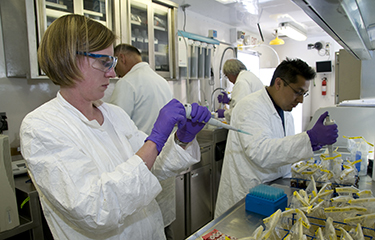Out of 186 samples recently tested by the U.S. Food and Drug Administration, per- and polyfluoroalkyl substances (PFAS) were discovered in two cod samples, two shrimp samples, one sample of tilapia, and one sample of salmon.
PFAS – so-called “forever chemicals” that don’t degrade and that are known to cause a variety of health issues if ingested – have become an increasingly concerning issue for seafood purveyors.
The results from the FDA’s latest data collection, which tested 186 samples taken at two separate collection points, revealed PFAS in 14 of 32 seafood samples, or 44 percent, and 74 percent of samples (60 of 81) in its 2022 targeted seafood survey.
“The data on PFAS in seafood is still very limited; However, our testing indicates that seafood may be at higher risk for environmental PFAS contamination compared to other types of foods,” it said in a 31 May press release.
In 2022, the first FDA-mandated recalls for PFAS in seafood were issued after it detected high levels of PFAS in canned clams sold by Bumble Bee and Crown Prince. Following its latest batch of testing, the FDA said those remain the only seafood products it has tested to register high enough levels of PFAS require a recall.
“Except for canned clams from China, we have determined that none of the other PFAS exposures with TRVs at the levels measured in the FDA’s testing of seafood are likely to be a human health concern,” it said. “For canned clams, voluntary recalls were issued by two firms, and we are continuing to test a limited number of import shipments at the border and domestic products on the market. Filter feeders, such as clams, but also other bivalve mollusks, including oysters, mussels, and scallops, have the potential to bioaccumulate more environmental contaminants than other seafood types. We are therefore pursuing additional sampling of imported and domestic bivalve mollusks to better understand PFAS in commercially available seafood.”
The FDA said it has tested nearly 800 fresh and processed food samples for PFAS since 2019, but it is still honing its methods and attempting to widen its sampling base and speed up the testing process. It recently began using high resolution mass spectrometry (HRMS) to determine whether any additional types of PFAS beyond those it has specifically tested for in the past are present in food for sale in the United States. It currently only tests for 30 types of PFAS, up from 16 it tested for in 2019, but there are thousands of types of PFAS used in commercial applications globally.
“Our testing for PFAS in the general food supply is ongoing and we are taking steps to expedite our testing schedule by increasing our lab capacity,” it said. “As the science evolves and as we advance our understanding of PFAS in commercial seafood, it is important that the seafood industry considers PFAS contamination in their products and complies with applicable regulations to ensure the safety of seafood commercially available. If the FDA finds that a detectable level of PFAS in a certain food raises safety concerns, we take action, which may include working with the manufacturer to resolve the issue and taking steps to prevent the product from entering, or remaining in, the U.S. market.”
The FDA said it was prioritizing testing of seafood to ensure the future supply of such a nutritious food source to U.S. consumers.
“The FDA is committed to maintaining the availability of safe seafood, as it provides key nutrients for children and adults,” it said. “We will continue to apply the latest science to increase our understanding of the levels of PFAS in seafood, the reasons for differences within and across types of seafood, and to help identify strategies that can reduce PFAS in seafood. To achieve our shared goal of a safe and nutritious seafood supply, we will continue engaging with industry to advance our understanding of PFAS in commercial seafood, such as understanding current testing practices, sources of PFAS in seafood products, and potential mitigation strategies. In addition, the FDA is available to provide technical assistance to industry as laboratories work to expand their analytical capabilities to test for PFAS in seafood.”
Photo courtesy of U.S. Food and Drug Administration







